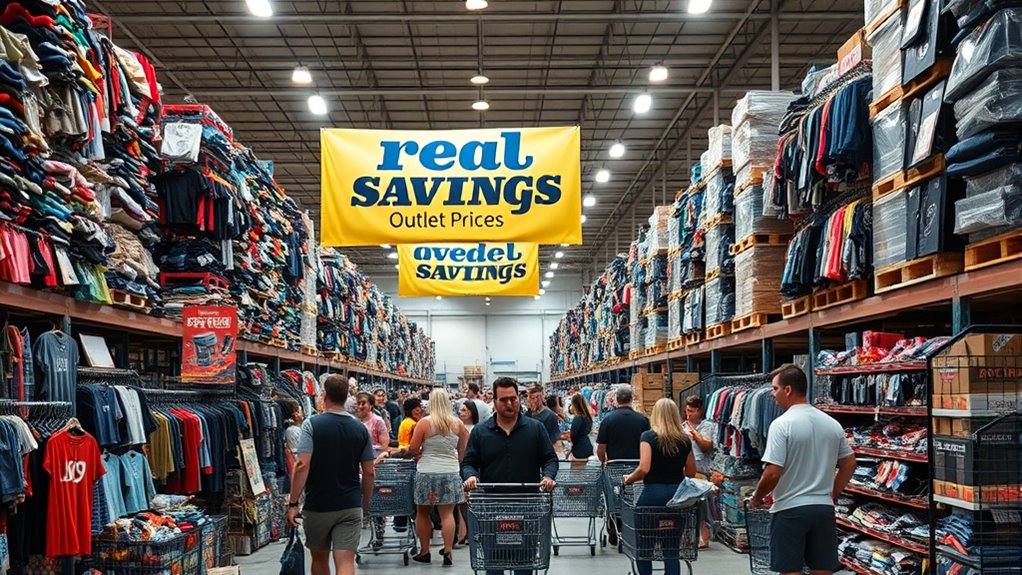Warehouse sales and outlet stores can offer real savings on brand-name products, but it’s important to understand how pricing works. They often sell authentic items at discounts due to overstock, out-of-season stock, or minor imperfections. While some deals are genuine, others may be inflated or hype-driven. If you stay aware of product conditions and pricing strategies, you can make smarter choices. Keep exploring to discover tips for getting the best value when shopping these outlets.
Key Takeaways
- Outlet stores typically sell genuine, branded products at discounts due to overstock, end-of-season items, or minor cosmetic flaws.
- Deep discounts at outlets often reflect inventory status, making savings real but sometimes limited by product condition.
- Proper research and awareness of pricing strategies help consumers distinguish genuine deals from marketing hype.
- Authentic outlet shopping offers significant savings on quality items, but overpaying for minor imperfections can diminish value.
- Overall, outlet stores and warehouse sales can provide real savings if shoppers understand inventory types and shop strategically.

Warehouse sales and outlet stores offer you a smart way to save money on brand-name products. These shopping venues are designed to attract bargain hunters like you who want quality without paying full retail prices. But before you plunge in, it’s helpful to understand how pricing strategies work behind the scenes. Many outlet stores sell products at a discount because they’re off-season, overstocked, or out of current retail cycles. This allows brands to clear inventory quickly while maintaining their core image. However, it’s important to weigh whether these discounts compromise brand authenticity. Some shoppers worry that deeply discounted items might be lower in quality or lack the same craftsmanship as full-priced products, but that’s not always the case. Many outlet stores sell authentic brand products that are perfectly legitimate, just priced lower due to their inventory status or minor cosmetic imperfections.
When you shop at outlet stores, you’re often getting products directly from the brand or through authorized channels, which helps verify authenticity. Retailers use various pricing strategies to create attractive deals that appeal to budget-conscious consumers. For example, they may mark up the original price slightly to create a perception of significant savings or bundle items to boost the perceived value. Sales and clearance events are also common ways outlets entice you to make a purchase, making it feel like a special deal rather than just a discounted item. This approach is designed to attract you into the store and encourage quick buying decisions. Additionally, understanding the pricing strategies behind outlet discounts can help you identify genuine savings versus marketing hype.
While outlet shopping can be a savvy move, it’s essential to stay vigilant about the genuine quality of what you’re buying. Sometimes, the discounts are offered on items with minor aesthetic flaws or discontinued lines, which might not meet the same standards as full-price merchandise. But if you’re aware of these factors, you can make informed choices and enjoy authentic products at a fraction of the regular cost. Remember, the key is to know what to look for and to trust reputable outlet stores that carry genuine brand-name items. With a little research and careful shopping, you can leverage these outlets to get authentic, high-quality products without overspending. Ultimately, whether it’s a savvy investment or just hype, shopping at warehouse sales and outlet stores can be a valuable way to stretch your budget if you approach it with awareness and confidence.
Frequently Asked Questions
How Do Outlet Stores Differ From Regular Retail Stores?
Outlet stores differ from regular retail stores mainly in their discount policies and store layouts. You’ll find outlet stores offer lower prices through discounts and less emphasis on store aesthetics, often with more straightforward layouts to focus on clearance deals. Regular stores tend to have a more polished presentation and consistent pricing, while outlet stores prioritize savings, making them an attractive option if you’re looking for deals on brand-name items.
Are Warehouse Sales Available Year-Round or Seasonal?
Warehouse sales are typically seasonal, happening only at specific times of the year, often aligned with inventory clearances or new product launches. However, some warehouse sales do offer year-round access, especially if they operate online or at fixed locations. To maximize savings, it’s best to stay informed about the sale schedules or sign up for notifications, so you don’t miss out on these limited-time deals or ongoing opportunities.
Can I Find Authentic Designer Brands at Outlet Stores?
Yes, you can find authentic luxury brand items at outlet stores, but you should stay cautious. Some outlets sell genuine designer products at discounted prices, while others might have counterfeit products mixed in. To guarantee you’re buying authentic, shop only at reputable outlet locations and verify their official partnerships with luxury brands. This way, you avoid falling for counterfeit products and enjoy real savings on genuine designer brands.
What Are the Best Times to Visit Warehouse Sales for Savings?
You should visit warehouse sales during off-peak times, like weekdays or early mornings, to maximize savings. Incorporate shopping tips into your travel planning by checking event schedules online and arriving early to beat the crowds. Avoid weekends and holiday seasons when demand is high and discounts are limited. Planning ahead helps you find the best deals, ensuring you get authentic designer brands at outlet prices without the hype.
Do Outlet Stores Offer Better Deals Online or In-Store?
You’ll usually find better deals online at outlet stores because of price comparisons and ongoing sales. Shopping online offers added convenience—you can browse multiple deals quickly, compare prices easily, and avoid crowds. However, in-store shopping lets you see products firsthand and possibly negotiate better prices. Weigh your priorities: if savings matter most, online may be your best bet, but for instant satisfaction, in-store shopping works well.
Conclusion
So, savvy shoppers, step carefully and stay skeptical. While warehouse sales and outlet stores can seem tempting, they often offer only fleeting savings and false frills. Don’t dive blindly into deals; do diligent detective work and decide if the discounts truly deliver. Remember, genuine gains come from smart shopping, not hype. Stay sharp, scrutinize sales, and savor the satisfaction of saving smartly rather than succumbing to superficial splurges.








